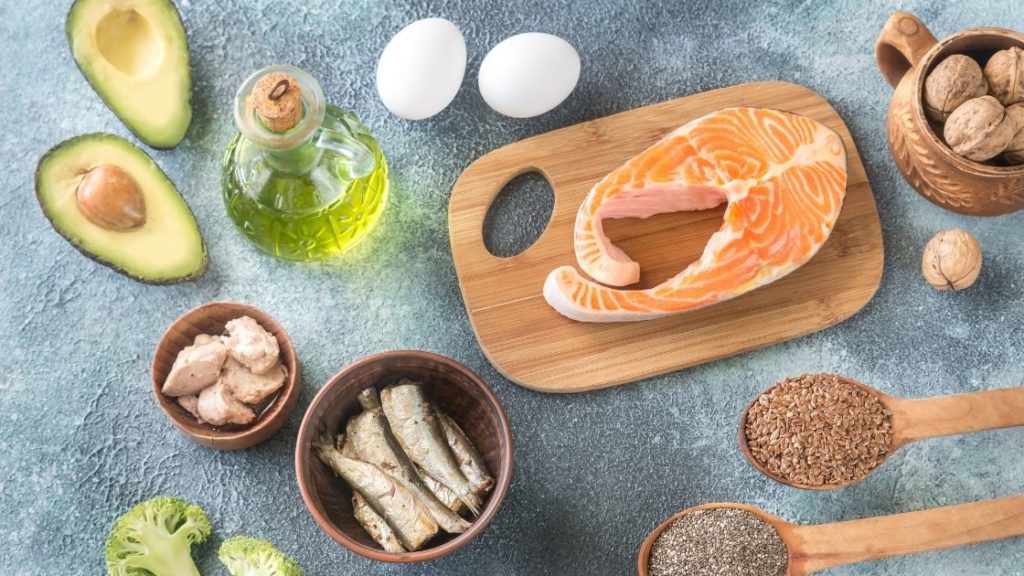Omega 3 vs Omega 6: How to Get to Ultimate Benefit!

We all need our healthy fats! Avocados, walnuts, olive oil… all those delicious sources are packed with health benefits and your body loves when you eat them!
You’ve probably heard about Omega-3 and Omega-6. Whenever a snack package is produced, be it a jar of wasabi almonds or a box of flax seed granola bars, you’ll see “Good Source of Omega 3 (or 6! Or both!)” on the front in giant letters.
But what you may not know, however, is that there is an ideal ratio for Omega-3 and Omega-6 consumption. If your diet is rich in one fatty acid and low in the other, you may be missing the ultimate benefit! The two are like one of those opposites-attract romances, in that they perform different functions in your body and therefore balance each other out perfectly! For example, the Omega-3’s found in oysters promote vasodilation, and the Omega-6’s found in peanut butter encourage vasoconstriction, and your blood vessels need their ability to widen and constrict to get your blood flowing properly! So, if you consume the right ratio of oysters to peanut butter, everything will function just as it should.
So, let’s talk about the yin and yang benefits of Omega-3 and Omega-6!
Omega-3 vs Omega-6
What do Omega-3 fatty acids do for your body?
- Promote vasodilation (or widening of the blood vessels)
- Function as anti-inflammatories
- Prevent blood clots
- Reduce pain
- Dilate airway
Now, Compare the Above-Mentioned Bullets to Omega-6’s Actions Listed Below!
- Promotes vasoconstriction (or narrowing of the blood vessels)
- Aids the inflammatory process (the innate defense response to pathogens)
- Assists with blood clotting
- Heightens pain signaling
- Increases airway contraction
Side by side, you can see why we should strive to get a 1:1 ratio of our Omega-3’s and 6’s. But in today’s world, the average American consumes an Omega-6: Omega-3 ratio of 16:1! This is due in part to sources of Omega-6, such as corn and safflower oil, being inexpensive when compared to most Omega-3 sources. That 16:1, regardless of Omega-6’s status as a healthy fat, increases one’s risk of complications and disease. What good are prolonged amounts of vasoconstriction, inflammation, blood clotting, pain signaling, and airway constriction doing for your body? Your Omega-6: Omega-3 ratio should be closer to 1:1 or 2:1 for the bodily functions to balance each other out!
Omega 3 Sources
- Fish – Mackerel, salmon, sea bass, oysters, sardines, shrimp, halibut, herring, anchovies, and trout are some of the richest sources.
- Seaweed
- Chia seeds
- Flaxseeds
- Hemp seeds
- Walnuts
- Edamame
- Kidney beans
Omega 6 Sources
- Safflower oil
- Canola oil
- Avocado
- Sunflower seeds
- Walnuts
- Almonds
- Peanuts
- Tofu
- Eggs
Did you notice that walnuts appear under both headings? Walnuts have an Omega-6:Omega-3 ratio of 4.2:1! For some perspective, the ratio for sunflower seeds is 311.5:1! So unless you have an allergy, be sure to eat your walnuts!
Now You Know!
Let the right balance of Omega-3’s and 6’s go to work on your bodily systems! Your heart, brain, lungs, and immunity will thank you!
Katrina Jenkins
Author, Licensed Massage Therapist
Katrina Jenkins graduated from Towson University in 2013 with a Bachelor’s Degree in Health Science and worked as a nurse’s aide briefly before pursuing her true passion. She graduated from the Massage Therapy Institute of Colorado in April 2016 with honors and completed the Touch of Healers Scholarship Program the following summer. She has been a part of the Moyer Total Wellness Team since the summer of 2017.
Resources
Clark, C.M., Monahan, K.D. and Drew, R.C. (2018). Omega-3 polyunsaturated fatty acid supplementation reduces blood pressure but not renal vasoconstrictor response to orthostatic stress in healthy older adults. Physiological Reports, 6(8), p.e13674.
DiNicolantonio, J.J. and OKeefe, J. (2019). Importance of maintaining a low omega-6/omega-3 ratio for reducing platelet aggregation, coagulation and thrombosis. Open Heart, [online] 6(1), p.e001011. Available at: https://openheart.bmj.com/content/openhrt/6/1/e001011.full.pdf.
Gal, K. (2020). 15 omega-3-rich foods: Fish and vegetarian sources. [online] www.medicalnewstoday.com. Available at: https://www.medicalnewstoday.com/articles/323144.
Jk, I. and Pc, C. (2018). Omega-6 Fatty Acids and Inflammation. [online] Prostaglandins, leukotrienes, and essential fatty acids. Available at: https://pubmed.ncbi.nlm.nih.gov/29610056/.
Lemoine S, C.M., Brigham, E.P., Woo, H., Hanson, C.K., McCormack, M.C., Koch, A., Putcha, N. and Hansel, N.N. (2019). Omega-3 fatty acid intake and prevalent respiratory symptoms among U.S. adults with COPD. BMC Pulmonary Medicine, 19(1).
Photo Credit
Canva by Oleksandr Prokopenko
Canva by adgafoto
